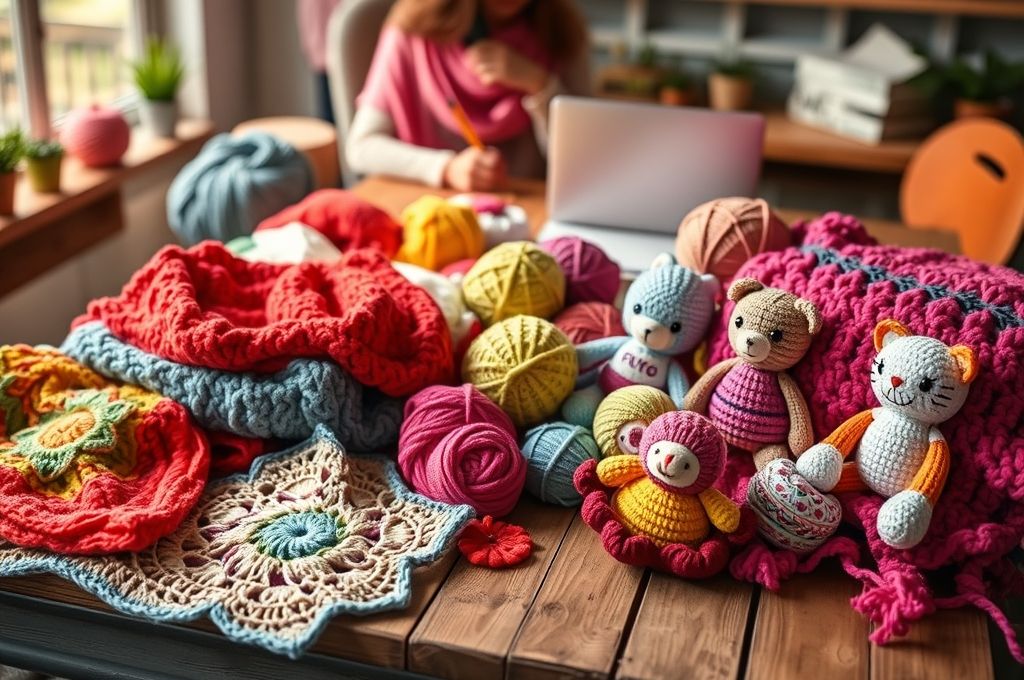Have you ever finished a beautiful crochet piece—maybe a cozy beanie, a delicate doily, or a vibrant amigurumi—and thought, “I could sell this!”? You’re not alone. Thousands of crafters around the world are turning their passion for crochet into profitable side hustles or even full-time businesses. But here’s the truth: creating stunning handmade items is only half the battle. The real challenge—and opportunity—lies in knowing how to price and market your work effectively.
Many talented crocheters struggle not because their products aren’t good (they are!), but because they undervalue their time, materials, and creativity. Others pour their hearts into their crafts but can’t seem to find the right audience. This guide is here to change that.
In this article, we’ll walk you through the essential steps to confidently price your crochet creations and market them successfully. From understanding your costs and setting fair prices to building a brand, leveraging social media, and connecting with buyers, you’ll gain practical insights you can apply right away. Whether you’re selling at local craft fairs, on Etsy, or through Instagram, this guide will help you turn your handmade passion into a sustainable and rewarding business.
Let’s get started.
- Know Your Worth: Why Pricing Matters More Than You Think
When you make something by hand, it’s easy to see only the yarn and the time it took. But pricing isn’t just about covering costs—it’s about valuing your skill, creativity, and effort. Many crafters make the mistake of pricing too low, thinking it will attract more buyers. In reality, underpricing can hurt your business in the long run.
Think of it this way: if you spend 5 hours crocheting a baby blanket using $8 worth of premium yarn, and you sell it for $20, you’re making less than minimum wage. That doesn’t account for design time, pattern development, marketing, or packaging. Over time, this kind of pricing leads to burnout and discouragement.
Pricing correctly does more than ensure you earn a fair income—it builds credibility. Customers often associate higher prices with higher quality. When you price your work appropriately, people are more likely to see it as valuable and worth investing in.
So, how do you find that sweet spot? Start by breaking down your costs:
Materials: Yarn, buttons, stuffing, labels, packaging.
Time: How many hours did it take? What’s your hourly rate?
Overheads: Tools, website fees, shipping supplies, electricity.
Profit margin: You should earn more than just break even.
A common formula used by crafters is:
Price = (Materials + Labor + Overhead) × 2
This “double your costs” method ensures you’re not just surviving, but thriving.
For example:
Yarn: $10
Time (3 hours at $15/hour): $45
Packaging & shipping supplies: $3
Total cost: $58
Selling price: $116
Yes, that might seem high at first, but remember—you’re not just selling a product. You’re selling art, care, and craftsmanship.
And here’s the good news: people are willing to pay for quality handmade goods—especially when they understand the story behind them.
- Beyond the Price Tag: The Psychology of Pricing Your Crochet Work
Now that you know how to calculate your costs, let’s talk about how you present your prices. The psychology behind pricing can make a big difference in how customers perceive your work.
For instance, have you noticed how many products are priced at $19.99 instead of $20? It’s not just a gimmick—studies show that left-digit bias makes $19.99 feel significantly cheaper than $20, even though the difference is just one cent.
You can use similar strategies in your pricing:
Use .99 or .95 endings: $34.95 feels more affordable than $35.
Offer tiered pricing: A small amigurumi for $25, medium for $35, large for $45. This gives customers options and encourages them to consider the higher-end product.
Bundle products: A matching hat and scarf set for $50 (normally $60 if bought separately) creates perceived value.
But pricing isn’t just about numbers—it’s about framing. When you list a $40 crochet blanket, don’t just say “handmade blanket.” Say:
“Handcrafted baby blanket made with 100% organic cotton yarn, designed for comfort and safety. Each stitch is made with love and attention to detail. Perfect for gifts or nursery decor.”
Suddenly, it’s not just a $40 item—it’s a story, a memory, a heirloom.
Also, consider your audience. Are you selling to budget-conscious parents? College students? Luxury gift shoppers? Your pricing should align with their expectations. A $120 custom wedding shawl will appeal to a different market than $15 crochet keychains.
And don’t forget confidence. If you believe your work is worth $60, say it with pride. Hesitation in pricing signals doubt—and customers pick up on that.
So, when setting your prices, ask yourself:
Am I covering all my costs?
Does this reflect the quality and time invested?
Will this price attract the right kind of customer?
When you answer yes to all three, you’re on the right track.
- Building Your Brand: Stand Out in a Crowded Market
Imagine two Etsy shops selling nearly identical crochet scarves. One has a generic name, blurry photos, and no story. The other has a warm brand name like “Stitch & Soul,” beautiful lifestyle images, and a heartfelt bio about the maker’s journey.
Which one would you trust more?
In the world of handmade goods, your brand is your story. It’s not just about logos or color schemes (though those help). It’s about who you are, why you create, and who you’re creating for.
Start by defining your brand identity:
What’s your style? Cozy and rustic? Modern and minimalist? Whimsical and colorful?
Who is your ideal customer? A busy mom looking for unique baby gifts? A plant-loving millennial who adores handmade decor?
What values do you stand for? Sustainability? Slow fashion? Mental wellness through crafting?
Once you have clarity, reflect that in every part of your business:
Shop name: Choose something memorable and meaningful.
Visuals: Use consistent colors, fonts, and photography style.
Voice: Write product descriptions and social media posts in a tone that feels authentic to you.
For example, instead of writing:
“Crochet beanie, size medium, blue.”
Try:
“Wrap yourself in warmth with this hand-crocheted beanie, made from soft, eco-friendly yarn in a calming ocean blue. Perfect for chilly mornings and cozy nights by the fire.”
See the difference?
Your brand also includes your packaging. A simple thank-you note, a branded sticker, or recycled tissue paper can turn a simple purchase into a memorable unboxing experience.
And don’t underestimate the power of consistency. Posting regularly, responding to messages promptly, and delivering on time builds trust—and trust leads to repeat customers and word-of-mouth referrals.
Remember: people don’t just buy products. They buy connection. When your brand feels personal and genuine, customers feel like they’re supporting you, not just buying an item.
- Where to Sell: Choosing the Right Platforms for Your Crochet Business
You’ve priced your items, built your brand—now where do you actually sell them?
The good news? There are more options than ever. The challenge? Choosing the ones that fit your goals, skills, and lifestyle.
Let’s break down the most popular options:
Etsy
Etsy is the go-to platform for handmade sellers. It has built-in traffic, easy setup, and tools for managing orders and shipping. The downside? Competition is fierce, and fees add up (listing fee, transaction fee, payment processing, plus optional ads).
Tip: Optimize your shop with strong keywords, clear photos, and detailed descriptions. Use tags like “handmade crochet gift,” “eco-friendly baby blanket,” or “amigurumi toy” to improve search visibility.
Instagram & Facebook
Social media is powerful for building a community. Post behind-the-scenes reels of you crocheting, share customer photos, and use Stories to announce new listings. You can even use Instagram Shopping to tag products directly.
Pro tip: Engage with your followers. Reply to comments, ask questions, and share your journey. People love seeing the person behind the craft.
Local Markets & Craft Fairs
Selling in person lets you connect directly with customers, get instant feedback, and build local support. Plus, you avoid online fees.
But: Booth fees, travel, and setup take time and money. Start with smaller events to test the waters.
Your Own Website
Platforms like Shopify or Squarespace let you create a professional online store. You keep more of your profits and have full control over branding.
Downside: You’ll need to drive your own traffic through SEO, ads, or social media.
Wholesale & Consignment
Once you’re established, you can supply local boutiques or gift shops. This can lead to bulk orders and steady income.
Caution: Wholesale means lower margins (typically 50% off retail), so adjust your pricing accordingly.
The best approach? Start small and test. Try one or two platforms, see what works, then expand. Many successful crocheters use a mix—Etsy for reach, Instagram for engagement, and occasional markets for fun.
- Marketing Magic: How to Get Noticed Without Feeling “Salesy”
Marketing doesn’t have to mean aggressive ads or pushy pitches. For handmade creators, the best marketing feels natural, authentic, and helpful.
Think of it as sharing your passion—not selling.
Here are five simple, effective strategies:
- Tell Your Story
People love to know who made their item and why. Share your journey:
When did you start crocheting?
What inspires your designs?
How do you choose your yarns?
A short “About Me” section on your website or shop can create an instant connection.
- Use High-Quality Photos
A blurry, poorly lit photo can make even the most beautiful piece look cheap. Invest in good lighting (natural light works great!) and take photos from multiple angles.
Show your item in use—a model wearing a scarf, a baby wrapped in a blanket, a mug cozy on a coffee cup. Lifestyle photos help customers imagine owning it.
- Encourage Customer Photos
Ask buyers to tag you when they use your product. Repost their photos (with permission) and thank them. User-generated content builds social proof and trust. - Offer Limited Editions or Seasonal Items
Create urgency with:
Holiday-themed items (e.g., pumpkin amigurumis in fall)
Limited color runs
“First 10 orders get a free gift”
Scarcity motivates action.
- Collaborate & Cross-Promote
Team up with other makers—like a jewelry designer or a candle maker—for joint giveaways or bundle deals. You’ll reach new audiences and build community.
And don’t forget email marketing. Even a simple newsletter with new launches, crochet tips, or exclusive discounts keeps customers engaged.
The key is to be consistent but not pushy. Share value, not just products. Celebrate your customers. Be human.
- The Power of Community: How Connection Fuels Success
Here’s a secret: some of the most successful crocheters didn’t make it alone. They grew through community.
Whether it’s a local crafting group, an online Facebook community, or a Reddit thread, being part of a supportive network can transform your business.
Why?
Feedback: Get honest opinions on your designs, pricing, or photos.
Support: Share struggles and wins with people who get it.
Inspiration: See what others are making and spark new ideas.
Opportunities: Learn about craft fairs, collaborations, or wholesale leads.
Take Sarah, a crocheter from Oregon. She started selling baby hats on Etsy but wasn’t getting sales. She joined a “Handmade Sellers Support Group” on Facebook, shared her shop link, and got dozens of helpful tips—from improving her titles to using better keywords. Within two months, her sales tripled.
You don’t have to do this alone.
And community isn’t just about receiving—it’s about giving too. Comment on others’ posts, celebrate their wins, offer encouragement. The more you give, the more you receive.
Even your customers can be part of your community. Send a handwritten note with each order. Ask for feedback. Feature “Customer of the Month” on your Instagram.
When people feel seen and valued, they become loyal fans—and that’s worth more than any ad campaign.
- From Hobby to Hustle: Making It Sustainable
Turning crochet into a business is exciting, but it can also become overwhelming if you’re not careful.
The goal isn’t just to sell more—it’s to enjoy the process and build something sustainable.
Here’s how:
Set Realistic Goals
Start small. Aim for 5 sales this month, not 500. Celebrate every win.
Batch Your Work
Instead of making one item at a time, crochet multiple pieces in the same color or style. This saves time and mental energy.
Automate What You Can
Use tools like:
Canva for social media graphics
Printful for print-on-demand packaging
Etsy’s shipping labels to save time
Take Breaks
Burnout kills creativity. Schedule rest days. Crochet for fun, not just profit.
Track Your Progress
Keep a simple spreadsheet of:
Items made
Time spent
Sales and profits
Customer feedback
This helps you see what’s working and adjust.
And remember: success isn’t just money. It’s also joy, freedom, and the ability to do what you love every day.
You don’t have to quit your day job tomorrow. Start as a side hustle. Grow at your own pace.
Conclusion
Selling your crochet creations is about more than making money—it’s about sharing your passion, expressing your creativity, and connecting with others. But to do it well, you need to price with confidence, market with heart, and build a brand that feels true to you.
We’ve covered a lot: from calculating your costs and using psychological pricing, to building a brand, choosing the right platforms, and growing through community. Each step brings you closer to a business that’s not only profitable but also fulfilling.
Now it’s your turn.
Look at your latest crochet piece. What does it cost in materials? How long did it take? What story does it tell? And most importantly—what is it worth?
Don’t undervalue your time, your talent, or your touch. The world needs more handmade beauty—and it needs your unique voice in the mix.
So go ahead: price fairly, market boldly, and share your work with pride.
And if you’re ready, drop a comment below—tell us about your favorite crochet creation, or what’s holding you back from selling. Let’s support each other on this creative journey.
Because when one maker succeeds, we all do.

Daniele Ferreira is passionate about the world of crochet, dedicating her time to exploring techniques, creating unique pieces, and sharing her knowledge with beginners and aficionados alike. With attention to detail and creativity, she transforms yarn into true works of art, inspiring others to discover the beauty and joy of this manual art.







